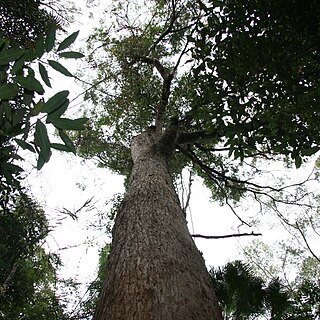Tree to 60 m with brown or red-brown rough softly fibrous bark throughout.. Juvenile leaves ovate, often crenulate; adult lanceolate, 8–13 cm long, 1.5–2.5 cm wide, usually crenulate; petiole terete to channelled, 0.8–1.5 cm long.. Umbels 7–9-flowered (Fl. Austral.), simple or in terminal and axillary panicles; peduncle flattened, 0.6–1.8 cm long [round in much East African material]; pedicels 2–7[9–10] mm long.. Buds clavate; operculum hemispherical, 1–2 mm long, 2–3 mm wide, often marked with crossed sutures.. Calyx-tube clavate, 3–5 mm long, 2–3 mm wide.. Fruits obconical, 4–10 mm long, 3–6 mm wide, usually 3-locular, with moderately broad steeply descending disc and 3–4 included to slightly exserted valves.. Fig. 8/24, p. 41.
Tree to 60 m. Adult leaves: lamina 8–13 cm long, 1.5–2.5 cm wide; lateral veins just visible to clearly visible, at 45°–60°; intramarginal vein up to 1 mm from margin; petiole terete to channelled, 8–15 mm long. Peduncle flattened, 6–18 mm long; pedicels 2–7 mm long. Operculum hemispherical, often with crossed sutures, 1–2 mm long, 2–3 mm wide; hypanthium clavate, 3–5 mm long, 2–3 mm wide. Fruits 4–10 mm long, 3–6 mm wide.
Tree to 60 m. Adult leaves: lamina 8-13 cm long, 1.5-2.5 cm wide; lateral veins just visible to clearly visible, at 45°-60°; intramarginal vein up to 1 mm from margin; petiole terete to channelled, 8-15 mm long. Peduncle flattened, 6-18 mm long; pedicels 2-7 mm long. Operculum hemispherical, often with crossed sutures, 1-2 mm long, 2-3 mm wide; hypanthium clavate, 3-5 mm long, 2-3 mm wide. Fruits 4-10 mm long, 3-6 mm wide.


